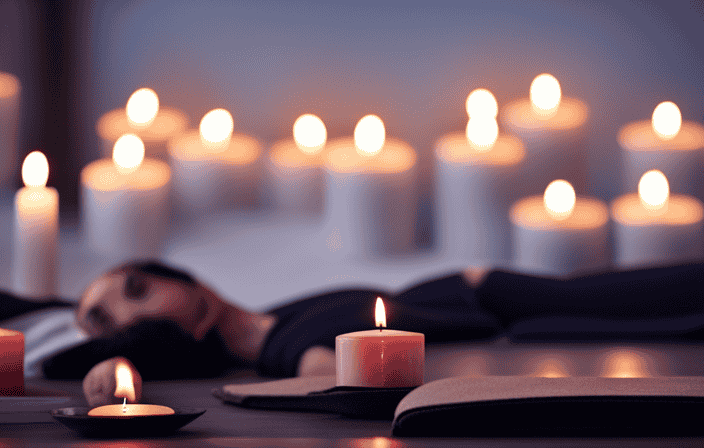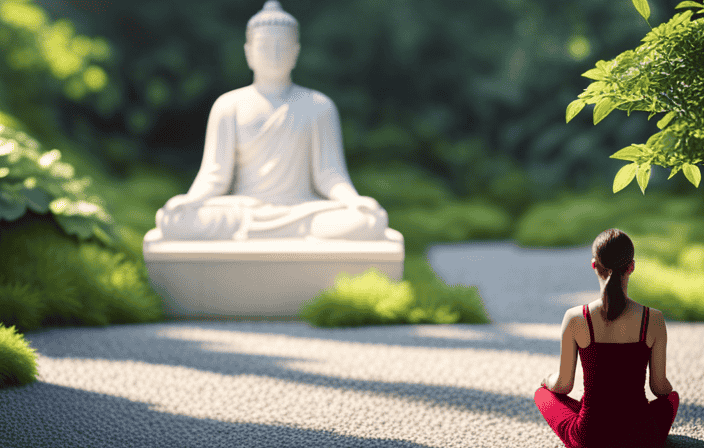In the fast-paced world we live in, it can be challenging to find moments of true relaxation. However, did you know that there is a simple yoga technique that can help you achieve deep relaxation?
Enter Shavasana, also known as Corpse Pose. This humble pose holds the key to releasing tension, cultivating mindfulness, and nurturing the body and soul.
In this article, we will explore the benefits, challenges, and precautions of Shavasana, and learn how to unlock its transformative power for our own well-being.
Key Takeaways
- Shavasana, also known as Corpse Pose, is an important relaxation pose in yoga that promotes deep relaxation and a meditative state of awareness.
- The practice of Shavasana has numerous benefits, including stress relief, emotional healing, and integration of mind, body, and spirit.
- Stillness, both physically and mentally, can be challenging in today’s fast-paced world, but regular practice of Shavasana helps in experiencing deep relaxation and overcoming these challenges.
- Shavasana is a crucial and underestimated part of a yoga practice that promotes mindfulness, self-awareness, and gratitude, and serves as a gentle reminder to honor and nourish the body and soul.
What is it?
Shavasana, also known as Corpse Pose, is a pose in yoga that allows me to release tension, promote deep relaxation, and cultivate a meditative state of awareness. It is a crucial part of my yoga practice, providing me with an opportunity to truly let go and find inner peace.
When I lie down flat on my back with arms by my sides and legs comfortably apart, I can feel the tension melting away from my body. The stillness and quietness of Shavasana allow me to connect with my breath and bring my attention inward.
It is during this pose that I can fully integrate the benefits of the preceding asanas and experience a profound sense of relaxation. Shavasana is like a reset button for my mind, body, and soul, reminding me of the importance of rest and restoration.
Benefits and Importance
I personally find it incredibly beneficial and important to prioritize practicing Shavasana, also known as Corpse Pose, in order to release tension, promote deep relaxation, and cultivate a meditative state of awareness.
Shavasana allows me to truly let go and surrender to the present moment, allowing for rest and restoration. It is during this pose that the benefits of the preceding asanas settle within, integrating the mind, body, and spirit.
The practice of Shavasana offers numerous benefits, including stress relief, emotional healing, and the opportunity to experience a deep sense of relaxation. It provides a space for me to let go of the busyness of life and reconnect with myself.
Shavasana reminds me to honor and nourish my body and soul, promoting mindfulness, self-awareness, and gratitude. It is the ultimate relaxation technique in yoga, offering a sanctuary for finding inner peace and allowing the body and mind to replenish and recharge.
I encourage everyone to make time for this powerful and transformative pose in their yoga practice.
Practicing Shavasana
During the practice of Shavasana, it is important to lie down on your back with your arms by your sides and your legs comfortably apart. This position allows for complete relaxation and surrender to the present moment.
As you settle into Shavasana, take a few moments to scan your body and consciously release any tension or tightness that may be present. Allow yourself to fully let go and sink into the support of the ground beneath you.
Close your eyes and bring your attention to your breath, feeling the gentle rise and fall of your abdomen. This is a time for deep rest and restoration, allowing the benefits of the preceding asanas to integrate within your body and mind.
Embrace this opportunity to connect with your inner self and cultivate a sense of peace and tranquility.
Challenges and Emotional Releases
Challenges and emotional releases may arise during the practice of Shavasana, requiring us to embrace and honor the emotions that surface. Stillness, both physically and mentally, can be challenging in our fast-paced world. However, regular practice of Shavasana helps us experience deep relaxation and overcome these challenges. It is not uncommon for individuals to experience emotional releases during Shavasana. This natural response indicates emotional healing and processing. It is essential to acknowledge and embrace the emotions that arise, allowing them to flow through us. To better understand the challenges and emotional releases in Shavasana, let’s take a closer look at the following table:
| Challenges | Emotional Releases | Benefits |
|---|---|---|
| Physical restlessness | Release of pent-up emotions | Deep relaxation |
| Mental distractions | Catharsis | Stress relief |
| Difficulty letting go | Emotional healing | Mind-body-spirit integration |
By recognizing and embracing these challenges and emotional releases, we can fully experience the power of Shavasana and unlock deep relaxation.
Contraindications and Safety
It is important to consider contraindications and safety measures when practicing Shavasana.
While Shavasana is generally safe for most individuals, there are certain situations where caution should be exercised.
If you have difficulty lying flat on your back, severe back pain, or certain respiratory conditions, it is advisable to consult with a qualified professional before attempting Shavasana.
Pregnant women in later stages of pregnancy should also take caution and modify the pose to ensure their safety and comfort.
Prioritizing your well-being and listening to your body’s needs is essential during the practice of Shavasana.
By being mindful and aware of any potential limitations or health concerns, you can create a safe and beneficial experience.
Remember, the goal of Shavasana is to promote deep relaxation and inner peace, so ensuring your safety is paramount.
Precautions and Modifications
To ensure my safety and comfort during Shavasana, I will consult with a qualified professional if I have any difficulty lying flat on my back, severe back pain, or specific respiratory conditions.
It is important to prioritize my well-being and take necessary precautions while practicing this relaxation pose.
If I experience difficulty in lying flat on my back, I can modify the position by using props such as blankets or bolsters to support my body. These props can provide the necessary comfort and alignment for a more relaxed experience.
Additionally, if I have severe back pain, I can explore alternative positions such as lying on my side or elevating my legs.
By making these small modifications and seeking guidance from a professional, I can ensure a safe and beneficial Shavasana practice.
Final Thoughts
Now that we have discussed the precautions and modifications for practicing Shavasana, let’s delve into some final thoughts on this powerful relaxation technique.
Shavasana is not just a pose to end your yoga practice; it is a gateway to deep relaxation and inner peace. It reminds us of the importance of rest and restoration, allowing us to honor and nourish our mind, body, and soul.
By practicing Shavasana regularly, we can cultivate mindfulness, self-awareness, and gratitude. It serves as a gentle reminder to slow down, let go of tension, and find solace in the present moment.
Whether it’s experiencing emotional releases or simply allowing ourselves to fully relax, Shavasana provides a profound opportunity for transformation and healing.
So, embrace the power of Shavasana and unlock the limitless potential of deep relaxation within you.
Recommended Time
When practicing Shavasana, I recommend dedicating a minimum of 5 to 10 minutes for this relaxation pose. This allows enough time for the body and mind to settle into a state of deep relaxation and cultivate a meditative awareness.
Here are four reasons why you should consider extending your Shavasana practice:
-
Deep relaxation: By giving yourself ample time in Shavasana, you allow your body to release tension and enter a state of profound relaxation. This helps to reduce stress and promote overall well-being.
-
Integration of benefits: Shavasana allows the benefits of preceding asanas to settle within. It gives your body the opportunity to absorb and integrate the physical and energetic shifts that occurred during your yoga practice.
-
Emotional healing: Longer periods of Shavasana can facilitate emotional releases. By embracing and acknowledging any emotions that arise, you create a safe space for emotional healing and processing.
-
Inner stillness: Extending your Shavasana practice allows you to experience a deeper level of stillness, both physically and mentally. This can be highly beneficial in today’s fast-paced world, where finding moments of tranquility is essential for overall well-being.
Remember, Shavasana is a gift you give yourself. So, take the time to honor and nourish your mind, body, and soul through this ultimate relaxation technique.
Frequently Asked Questions
Can Shavasana be practiced by beginners?
Yes, beginners can practice Shavasana. It is a simple pose that involves lying down and relaxing. It is important for beginners to start with shorter durations and gradually increase the time as they become more comfortable.
What are some common emotional releases experienced during Shavasana?
During Shavasana, common emotional releases can include tears, laughter, or feelings of sadness or joy. These releases are a natural response and indicate emotional healing and processing. It’s important to embrace and honor these emotions.
Are there any specific props that can be used to modify the Shavasana pose?
Yes, there are several props that can be used to modify the Shavasana pose. Some common props include blankets, bolsters, and eye pillows, which can provide support and enhance comfort during the relaxation pose.
How does Shavasana promote integration of mind, body, and spirit?
Shavasana promotes integration of mind, body, and spirit by allowing us to fully surrender and let go. In this pose, we cultivate a state of deep relaxation, releasing tension and creating space for inner peace and connection.
Can Shavasana be practiced during pregnancy?
During pregnancy, it is important to practice caution when doing Shavasana. It is best to consult with a qualified professional as the practice may need to be modified to ensure the safety and well-being of both the mother and baby.










